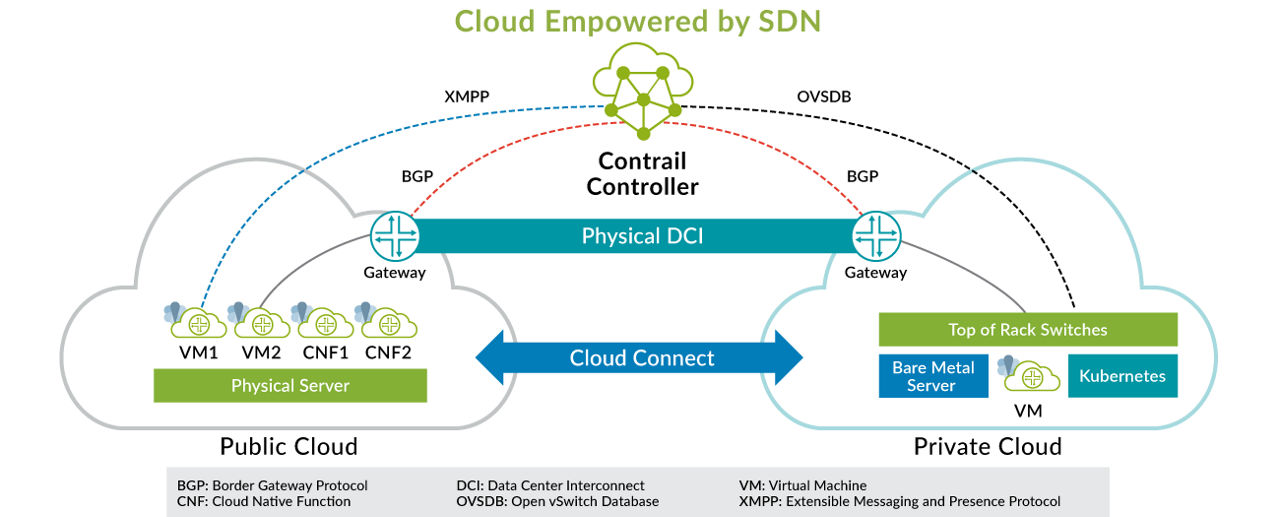What is SDN?
What is SDN?
Software-defined networking (SDN) is an approach to network virtualization and containerization that helps optimize network resources and quickly adapt networks to changing business needs, applications, and traffic. It works by separating the network's control and data planes to create a software-programmable infrastructure.
With SDN, the functions of network orchestration, management, analytics, and automation become the job of SDN controllers. The controllers can take advantage of the scale, performance, and availability of modern cloud computing and storage resources. Increasingly, SDN controllers are built on platforms with open standards and APIs, enabling them to orchestrate, manage, and control network equipment from different vendors.
SDN delivers many business benefits. Separation of the control and data transport layers increases flexibility and accelerates time-to-market for new applications. The ability to respond more swiftly to issues and outages improves network availability. Finally, programmability makes it easier for IT organizations to automate network functions and reduce operating costs.
SDN dovetails with another technology, Network Functions Virtualization (NFV). NFV offers the ability to virtualize appliance-based network functions such as firewalls, load balancers, and WAN accelerators. The centralized control that SDN provides can efficiently manage and orchestrate these virtual network functions (VNFs) enabled by NFV.

What Problems Does SDN Solve?
SDN eases the complexity of managing highly distributed physical network infrastructures with programmability and centralized control. IT organizations can manage the end-to-end network in software from a central location and automate certain aspects of network operations. In this way, SDN accelerates network deployment, configuration changes, and troubleshooting, which reduces operational complexity and cost. It also speeds the resolution of network issues and outages for improved uptime and better user experiences.
How Does SDN Work?
SDN decouples control plane software from networking hardware, allowing network administrators to use APIs to programmatically provision and manage remotely connected devices. SDN provides a common interface to control the entire distributed network, relieving IT from having to upgrade, troubleshoot, and manage each device individually.
SDN FAQs
What Are the Benefits of SDN?
SDN reduces network operations complexity and cost while accelerating the resolution of network issues and outages. These capabilities enable the following benefits:
- Simplified operations – SDN provides a single pane of glass to manage the network as a whole and eliminates the time and manual errors associated with managing each device independently.
- Open infrastructure – Open APIs and standard overlay tunneling connect public and private clouds for easy workload portability and business agility.
- Operational economics – SDN controllers integrate virtual and physical networks, allowing administrators to select hardware forwarding planes that are application-optimized based on cost, performance, latency, and scale.
- Greater network uptime. Faster resolution of network issues increases the network’s availability and improves user experiences.
What’s the Difference between SDN and Traditional Networking?
Traditional networking uses fixed-function hardware appliances like switches, routers, and firewalls to deliver networking services. Each traditional networking element is configured independently, which can be time-consuming and operationally challenging as the network scales.
By contrast, SDN uses virtualization to accelerate network provisioning and management by allowing operators to perform these functions, networkwide, in centralized SDN controllers using an abstract copy of the physical network. SDN controllers also centrally store and manage forwarding tables for overall improved traffic flows throughout the network.
What Role Does SDN Play in Network Automation?
In a traditional network, moving devices and applications requires manual oversight. Network reachability and security require remapping devices’ IP addresses. SDN automates this process, which is critical for managing temporary workloads and virtualized services spun up dynamically to meet short-term demands. In an SDN, workloads and services are created with network membership, reachability, and security policies automatically assigned and enforced to simplify operations and improve security.
What’s the Difference between SDN and SD-WAN?
SDN is typically thought of as a data center solution; however, extending the SDN application and technology across the wide-area network creates an SD-WAN. The combination and integration of SDN controllers across different network domains is how communication services providers (CSPs) can deliver a ubiquitous cloud fabric that connects all compute and storage, from their radio access networks (RANs) to their transport and core networks.
What Are Some SDN Security Considerations?
SDN eases network microsegmentation, which entails creating network zones that isolate workloads from one another and securing them individually. Using microsegmentation, system administrators can build policies to limit network traffic between segments based on a Zero Trust security approach. This setup also blocks an attacker from moving from a compromised workload or application in one segment to another, which contains the impact of the breach.
Cloud-native workloads can be further deconstructed into microservices, which create new interfaces that present new attack surfaces for malicious actors. As such, microservices create a greater dependency on both the network and the security policies to protect API calls and control traffic that was previously localized.
What SDN Solutions Does Juniper Offer?
Juniper’s SDN solution is designed for each layer of the service provider network. At the heart of the solution is Contrail Networking, a cloud network SDN product that automates the creation and management of virtualized overlay networks of cloud users, devices, applications, and workloads. Another component, Juniper Apstra, provides complete data center fabric management to automate Day 0 through Day 2 operations. Finally, Paragon Automation provides intent-driven automation across the network’s “plan, orchestrate, correlate, and optimize” lifecycle.






















